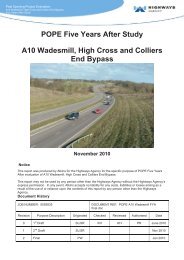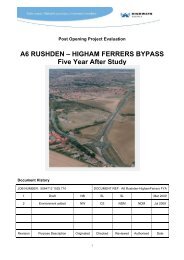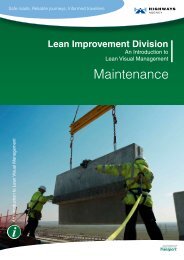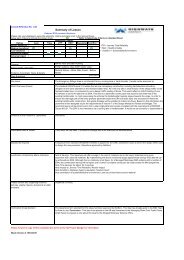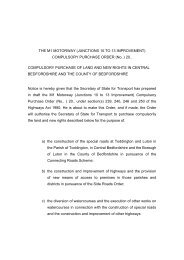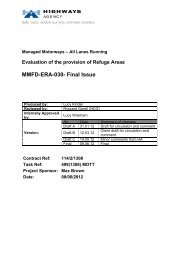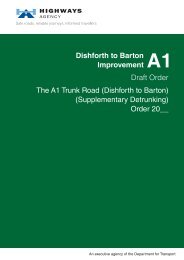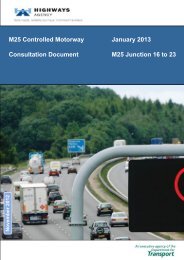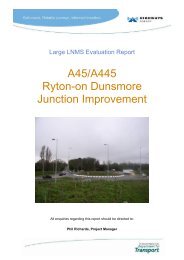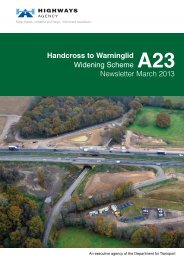A1(T) Elkesley Junction Improvements - Highways Agency
A1(T) Elkesley Junction Improvements - Highways Agency
A1(T) Elkesley Junction Improvements - Highways Agency
Create successful ePaper yourself
Turn your PDF publications into a flip-book with our unique Google optimized e-Paper software.
1.2 Need for the SchemeThe need for the scheme is acknowledged in the <strong>A1</strong>(T) Peterborough and BlytheRoute Management Strategy (RMS) as part of the 3-year work programme. InOctober 2002, the improvements of the <strong>Elkesley</strong> junctions were identified as ’PriorityAction Sites‘. The strategy recognised the following problems along the route:• Safety - Central reserve gaps, numerous at-grade junctions and privateaccesses of varying standards, dangerous to join and leave the <strong>A1</strong>(T), poorsigning, lack of driver information, poor location of lay-bys.• Economy - Congestion, delays due to maintenance, accidents, abnormalloads and high traffic flows.• Accessibility - Walkers, cyclists and horse riders experience difficultiescrossing the road, community severance, poor access to bus stops.1.3 Scheme ObjectivesThe detailed scheme objectives are:• improve road safety for all travellers;• reduce journey times along the <strong>A1</strong>(T);• improve accessibility within the locality and to the wider area, andaccessibility to everyday facilities for all, especially those without a car;• contribute to an efficient economy, and to support sustainable economicgrowth in appropriate locations;• protect and enhance the natural and built environment; and• promote the integration of all forms of transport and land use planning,leading to a better more efficient transport system.1.4 Background to the Environmental AssessmentIn accordance with the screening process set out in DMRB Volume 11, Part 3(HD47/08), the HA has determined that an EIA is not required for this scheme. It isHA policy to “undertake an appropriate level of assessment to ensure thatinformation about the environmental effects of projects is collected, assessed andused to inform option choice, planning, design and decision making and to promotesustainable development and other environmental policies”.This EAR follows on from the Stage 2 report, which identified the Preferred Version.This report therefore assesses the potentially significant impacts of the PreferredVersion, against the requirements of the European Directive on EIA as transposed inEngland by the <strong>Highways</strong> Act 1980 (as amended).16



